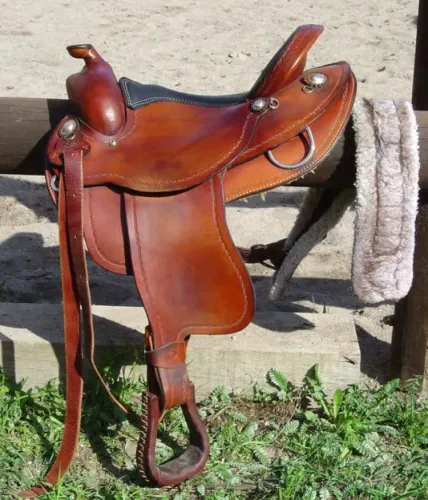
When it comes to horse riding, the saddle is not merely a piece of equipment; it's a crucial interface between the rider and the horse. Australian saddles, renowned for their distinct design and versatility, have garnered attention from riders worldwide. Among the various types of saddle, the Australian stock saddle stands out as a symbol of tradition and utility. In this article, we'll delve into the realm of Australian saddles, exploring their characteristics, advantages, disadvantages, and the specific features of the Australian stock saddle.
Australian Saddles: A Brief Overview
Australian saddles have a rich history deeply rooted in the equestrian heritage of the continent. These saddles were developed to suit the demanding conditions of Australia's rugged landscapes, where riders needed equipment that provided comfort, stability, and security during long rides across various terrains.
Australian saddles have a distinctive shape. This design helps riders maintain balance and control, especially during activities like cattle herding and trail riding. Australian saddles are used in a variety of equestrian disciplines, from endurance riding to stock work, and even recreational riding.
Advantages of Australian Saddles
Comfort for Long Rides: The deep seat and well-padded design of Australian saddles ensure rider comfort during extended rides. This is particularly important for stockmen and endurance riders who spend hours in the saddle.
Stability and Security: The high pommel and poley pads offer a secure fit, preventing the rider from sliding forward or losing balance during sudden movements or challenging terrains.
Versatility: Australian saddles are versatile enough to accommodate various riding styles and activities. Whether you're participating in cattle work, exploring trails, or competing in endurance events, these saddles are up to the task.
Durable Build: Crafted with rugged landscapes in mind, Australian saddles are constructed to withstand wear and tear. They are often made from high-quality leather or synthetic materials, ensuring longevity even in harsh conditions.
Weight distribution: These saddles distribute the weight of the rider over a larger area than an English saddle.
Connection with Tradition: For many riders, Australian saddles represent a connection to the rich heritage of horsemanship in Australia. They evoke a sense of tradition while adapting to modern riding needs.
Disadvantages of Australian Saddles
Weight: One notable drawback of Australian saddles is their weight. Due to their robust construction and added features, these saddles can be heavier than some other saddle types. This might not be suitable for riders looking for a lightweight option. Nevertheless, Wintec produces a synthetic Australian saddle that weighs about 17 lbs which is a typical weight for a well-made English saddle.
Limited Jumping Support: While Australian saddles are versatile, they are not suitable for high-level jumping activities. This is because they are not designed with forward-cut panels with knee rolls and it is harder to ride in a forward jumping seat. The Australian saddle also has poleys that anchor the rider so it is difficult to get out of the saddle when jumping.

Article Suggestion
Discover the Benefits of Modern Lightweight Saddles for Heavy RidersThe Australian Saddle: A Closer Look
The Australian saddle has a distinct design tailored to the needs of stockmen and riders who spend their days working with livestock. Let's explore some key features of the Australian stock saddle:
Deep Seat: The deep seat of the Australian stock saddle enhances rider stability during manoeuvres, making it ideal for cattle work and other demanding tasks.
High Pommel and Cantle: The high pommel and cantle helps keep the rider secure in the saddle, even when dealing with unpredictable livestock or navigating uneven terrain.
Horn: Unlike English saddles, Australian stock saddles often feature a horn at the front. This horn serves as an additional handle for stockmen to hold onto when roping or handling cattle.
Poleys: These are unique to Australian saddles and sit close to the rider's upper thigh. They permit the rider to brace against sudden movements without losing balance. They are good for keeping a rider secure on a horse that suddenly makes a 180-degree turn. and effectively prevents the rider's leg from coming across the saddle. Poleys do not prevent the rider from using the rising trot.
The activities suitable for an Australian Saddle
The Australian saddle is highly serviceable. It can be used for the following activities:
- Polocross
- Endurance riding
- Stock work
- Hacking/trail riding
- Dressage.

Case study example
In this example Sabrina is on the forehand but otherwise showing a lovely extended trot in a stock saddle.
The take-home Message
The Australian saddles embody a blend of tradition and utility. They have evolved to meet the demands of different equestrian activities while maintaining a connection to Australia's equestrian heritage. With their focus on rider comfort, stability, and durability, Australian saddles are a preferred choice for many riders engaged in stock work, endurance riding, and recreational trail riding. While their weight might be a concern for some riders, the benefits they offer in terms of versatility and connection to tradition often outweigh this drawback.
So, whether you're traversing the rugged Australian outback or exploring trails in your local area, the Australian saddle is a reliable companion that stands as a testament to the harmonious partnership between horse and rider.Australian stock saddles are the choice of stockmen riding the outback. They need a robust working saddle and this suits their purpose. These saddles are closer to English saddles than Western saddles but there are differences.

Article Suggestion
The Horse Owners Guide to Treeless Saddles
